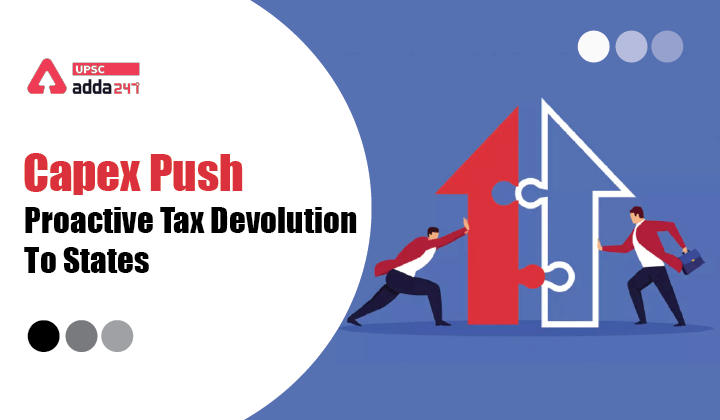Why in the News?
The Centre will transfer Rs 95,082 crore to states by November 22, of which Rs 47,549 crore is their due as part of tax devolution and a matching amount of Rs 47,549 crore is also their due but is being frontloaded to increase their capital expenditure.
Present status of Tax Devolution to the States
- At present, 41 per cent of the tax collected is devolved in 14 instalments, which gives predictability of cash flows to states and most states are not in a negative cash balance. Rs 2.66 lakh crore of positive cash balance was there as of October 30, and only four states had negative cash balance.
Why this front-loaded approach by the Centre?
- With growth being severely impacted by the pandemic and private capital expenditure showing no signs of picking up, the Centre had resolved to increase its capital expenditure substantially for FY22 and had also nudged States to do likewise.
- It has also been incentivising States to increase their capex spending through enhanced ceilings for borrowings and interest-free loans.
RBI’s New Retail Direct Scheme
Centre’s Initiatives to increase States’ Capex
- Recently launched National Monetisation Pipeline includes only Central government assets and state assets have been out of its purview, suggesting that there is a potential monetisable asset base in states, which could be leveraged to enhance the capital for new infrastructure creation.
- Typically, the tax devolution to states is done in 14 instalments in a year and the adjustments as per the revised estimate are usually done in March.
- But now to improve the liquidity of states, the Centre has already released the entire back-to-back loan component of Rs 1.59 lakh crore to the states in lieu of shortfall in the release of GST compensation during the current fiscal.
- This was in addition to the compensation released to the states from the designated cess kitty of Rs 60,000 crore.
States’ Demand
- Some of the states asked for further relaxation of FRBM to enhance borrowings. Some wanted the interest-free 50-year loan scheme of the Centre (for capex boost) to be continued,” the Union finance minister said.
- Many states have committed to having a dispute resolution mechanism post the signing of the contracts.
- Some states have suggested a special scheme to promote offshore wind power generation as they are firmly on their path of bolstering capex.
Centre’s Appeal to States
- The Centre has asked states to undertake Rs 1.1-lakh-crore more capex in FY22 than Rs 5 lakh crore achieved in pre-Covid year of FY20.
- The states are allowed net borrowing of 4% of GSDP in FY22 with 50 basis point of this linked to achievement of incremental capex over their investment in FY20.
Capex in the social sector
- Both revenue and capital expenditures of States are classified under general, social and economic sectors.
- Not surprisingly, a bulk of the State’s capex spending went into the social sector which includes spending on building healthcare infrastructure and education.
- The many States have ramped up hospitals and emergency facilities to manage the Covid crisis.
What States can do to increase Capex?
- In many cases land is one of the major bottlenecks for project on-grounding, for which states must contrive to smoothen land acquisition procedures and create land banks to be tapped at the time of investment.
- The quality of expenditure by states is important as on average they incur 60 per cent of the general government expenditure (the Centre plus state combined), whereas the global average of sub-national spending is just about 30 per cent.
- After the global financial crisis, many states, eager to comply with tight fiscal parameters, had cut down on their capital expenditures. That should not be repeated again.
India Ahead of China in Financial Inclusion Metrics
Why Centre Incentivising Capex?
- Capital expenditure, by its nature, has a high multiplier effect with an ability to crowd-in private investments which in turn enhances the production capacity leading to higher economic growth and employment generation.
- It is for this reason that the Centre has been constantly nudging States to boost their capital spending, especially to regain growth in the aftermath of the global pandemic.
- Moreover, the States’ capital expenditure has a higher growth multiplier potential than the Centre as it is related closer to the local community.
Conclusion
The time has come to develop certain measurable parameters to assess the quality of expenditure. All our parameters are quantitative, but it is the quality of expenditure that is very important. States’ spending on infrastructure, for example, can have a greater multiplier effect, “which makes a difference to the lives of people in terms of education, health and skills”. In this context, measurable parameters have to be developed.



 TSPSC Group 1 Question Paper 2024, Downl...
TSPSC Group 1 Question Paper 2024, Downl...
 TSPSC Group 1 Answer key 2024 Out, Downl...
TSPSC Group 1 Answer key 2024 Out, Downl...
 UPSC Prelims 2024 Question Paper, Downlo...
UPSC Prelims 2024 Question Paper, Downlo...




